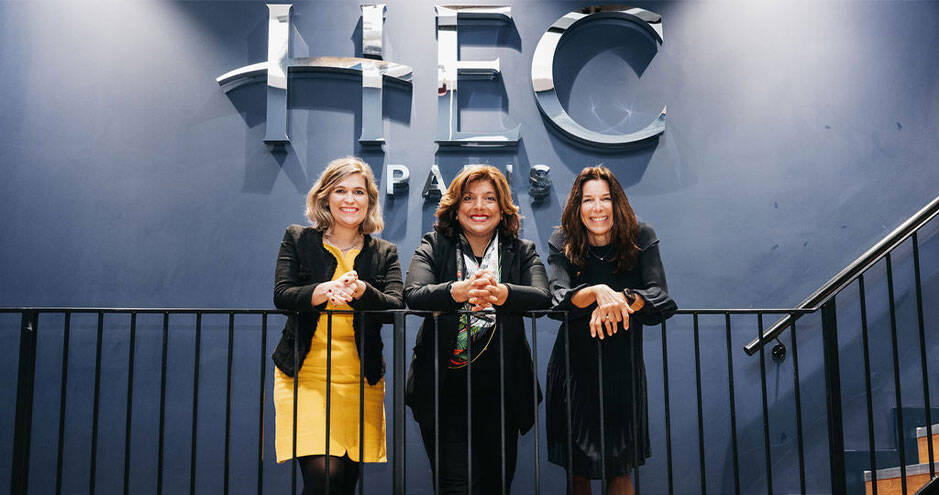Think Leader, Think Woman. How Women can Lead with Intention
Despite significant progress in women's representation in the workforce over the past 60 years, recent research from HEC Paris reveals a persistent gender gap in leadership aspirations, potentially perpetuating disparities at the top levels. As women grapple with internalized gender stereotypes, they often perceive themselves as different from the archetypal leader. However, women worldwide are driving innovation, revenue generation, competitiveness, and sustainability, making them essential engines of development. To confidently embrace leadership roles, women must recognize their strengths and capitalize on them. And what better way to do so than by learning from the best?

As we celebrate International Women’s Day on March 8th, we dive into an insightful conversation with Shaheena Janjuha-Jivraj, Anne-Valérie Corboz, and Delphine Mourot - Haxaire, the three distinguished authors of “Take the Lead: How Women Leaders are Driving Success through Innovation.” Drawing from their deep knowledge and experience, their insights echo the teaching of the Women Leadership Program at HEC Paris Executive Education.
"Take the Lead" emphasizes the importance of closing the gender gap in leadership positions. From your perspective, how can increased representation of women in leadership roles contribute to fostering a culture of innovation in businesses?
SHAHEENA: For nearly a decade research has shown a correlation between gender diversity and business performance, and increasingly this acknowledges innovation. When you have diverse perspectives and experiences, the right leadership can unlock truly new ideas and innovative approaches to problem-solving.
Editor’s note: According to a study from 2019, beliefs about gender diversity create a self-fulfilling cycle, where countries and industries that value diversity capture its benefits. A BCG study suggests that increasing the diversity of leadership teams leads to more and better innovation and improved financial performance. Both in developing and developed economies, companies with above-average diversity on their leadership teams report a greater payoff from innovation and higher EBIT margins. These studies emphasize that gender diversity is not only essential for social equity but also positively impacts business outcomes. Diverse perspectives and experiences foster innovation, enhance problem-solving, and contribute to overall organizational success.
How do you believe women leaders can leverage their unique perspectives and experiences to drive innovation within organizations?
SHAHEENA: As more women take on leadership roles, the nature of leadership shifts, and we are more likely to see greater collaboration and openness around discussions, which are essential to nurture innovation across teams. The women we interviewed for the book demonstrated innovation not only in how they encouraged creativity in their teams, but also in how they shaped their careers. We have many examples of women who recognized their skills and moved into senior leadership roles while also adapting roles that played to their strengths.
In your expertise, considering the Executive program's emphasis on innovation, what strategies do you suggest for female executives to cultivate strategic vision and decision-making capabilities, enabling them to effectively spearhead innovation initiatives? Could you share practical insights to assist them on their journey towards fostering creativity and driving organizational innovation?
ANNE-VALERIE: The question here is more around how women leaders feel empowered to take the lead and spearhead innovation initiatives. This depends on two dimensions: firstly, being in a corporate environment that values and embraces diversity. One that understands what women bring to the table in terms of diversity, unique approaches to problem-solving, creative resolution of existing challenges, and a different perspective on consumers and markets. Second, women need to own those strengths and put them forward. For example, women are very strong at curating diverse, high-performing teams. In turn, those teams build better solutions and services for the markets served.
Editor’s note: In line with this perspective, one objective of the Leadership Program is to guide companies toward achieving better enterprise-wide gender diversity by elucidating the quantitative and qualitative benefits of diversity to garner support for change.
Can you provide some inspiring examples or insights on how women leaders have successfully navigated crises and fostered innovation within their organizations?
DELPHINE: We've interviewed numerous women leaders who have not only navigated crises but also sparked innovation within their organizations. What emerges from their narratives is a recurrent theme of finding themselves in unfamiliar territory and pioneering solutions uniquely tailored to their circumstances. Often, they tapped into their inherent creativity and problem-solving skills, sometimes without fully realizing the depth of their resourcefulness until reflecting on their experiences. Against stereotypes and traditional narratives surrounding gender roles, we've aimed to bring transformative and inspiring stories. Take, for instance, the story of a woman who, faced with the challenge of relocating across continents due to her husband's job, established her own company, making it flourish across borders—her company became her 'suitcase,' following her through countries. Another poignant example features Sarah, whose life-altering accident prompted a deep reflection on how, when faced with challenging circumstances, the ability to think swiftly and innovatively can mean the difference between chaos and control.
How can women leaders play a key role in driving this reinvention and leading organizational transformation towards innovative business models?
ANNE-VALERIE: By doing the above, with intention. We need to recognise new business models are emerging. Leadership adapts when there is great gender diversity, initially, the changes are incremental, but over time, the small steps before sizable shifts change the nature of leadership towards greater innovation and creativity at the heart of the business. It’s no longer enough to assume innovation sits with senior leaders or an elite group, but instead recognise where organizational culture encourages innovation, teams perform better, particularly when facing uncertainty.
As a gift for International Women's Day on March 8th, what empowering message or advice would you share with executive or aspiring executive females to inspire and support them on their leadership journey?
DELPHINE: When we started working on the book, we wanted to work on the concept of luck as we were hearing very inspiring women attribute their success to luck and we wanted to understand and challenge this. The message I’d like to share with executive or aspiring executive females is a call to action: seize the moment to pause and reflect on your journey, and objectively assess where your talents are, recognize the areas where you've been challenged and grown, and discern the valuable lessons gleaned from each experience. Connecting these dots along your career trajectory allows you to truly claim ownership of your accomplishments and confidently step into leadership roles. So, embrace the opportunity to 'take the lead' today!
In a recent feature published by Daniel Brown on HEC Paris' website, the three authors explain how Creativity, Compass, Courage, Connection, Champions, Curating teams and Careers can help women navigate the leadership gap.
Are you a woman leader preparing for a senior leadership role? Are you ready to elevate your leadership behaviors, lead high-performing teams, and significantly impact the organization? Let us help you accelerate your career and effectively lead your organization. HEC Paris invites you to our high-impact Women Leadership Program. This program is designed to leverage your unique talents and prepare you for your future role. Our award-winning team of professors will guide you through the most cutting-edge approaches to job crafting, cultivating executive presence, leading teams, harnessing organizational culture, managing crises, and designing forward-looking organizational strategies. Now is the time to embrace your future and step into the leadership role you were meant for.
